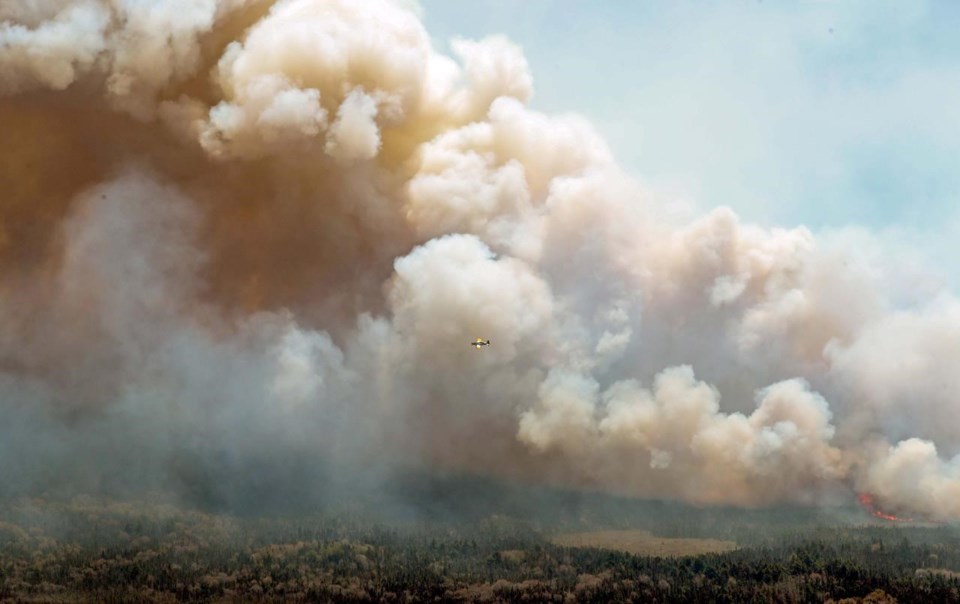BARRINGTON, N.S. — Nova Scotia firefighters are combing the charred woodlands of southwestern Nova Scotia for hot spots using a combination of infrared detectors in the air and blackened, steel-toed boots on the ground.
David Steeves, a spokesman for the Department of Natural Resources, said in an interview Monday that after the fire started May 27 it leapt over barrens and rocks, consuming highly flammable black spruce as it spread to 234 square kilometres in area.
He said the province's largest fire in recent history is no longer growing, but it isn't under control. He also cautions that the battle will continue for weeks, even as residents who've lost homes and possessions assess the damage.
From the air, two provincial helicopters are going up in the morning, as weather permits, using heat detection systems to locate areas of potential ignition, and guiding teams of firefighters to those locations.
Meanwhile, Steeves said teams of firefighters must walk over the often smouldering grounds, looking for hidden sparks which could set the woodlands alight again.
"Hunting hot spots is what we're doing. This part of the process is the most important part, because it helps us to ensure we don't take a step backwards," he said at the firefighting headquarters in the municipal building in Barrington, N.S., about 200 kilometres southwest of Halifax. The work is labour intensive and often monotonous.
"It just entails a lot of walking, a lot of observation, a lot of patrol," Steeves said. "But it's the most important. You're looking in places that aren't obvious. You're ripping apart rotten tree stumps, you're looking under giant rocks ... there's lots of places for fire to hide."
Fifty-five firefighters from Nova Scotia are fighting the wildfire, along with five from Prince Edward Island, 14 from Newfoundland and Labrador, 17 from the United States and 41 dispatched by the federal government. Volunteer and municipal firefighters are on call.
As the firefighters continued their work, people who've suffered damage have now been shown photos of their lost homes and damaged properties. The blaze forced more than 6,000 people from their homes and destroyed about 50 houses and cottages, as well as 150 other structures.
On Peter Sutherland’s 26-hectare blueberry farm in Clyde River, the blaze came to the edge of his blueberry fields, and consumed key equipment. His Kubota tractor sits, skeletal and charred, with hot metal pooled around the wheels.
“Anywhere (the fire) had dry fuel, it sort of bit me in the back end,” Sutherland said, surveying the damage.
The fire snaked from the nearby highway, down the back of Sutherland’s field, jumping to devour the tractor, cords of wood stored for winter, an old school bus full of lumber and a shed storing oil, pumps and generators, in some cases leaving nothing but a pile of loose nails and metal coils in its wake.
The tractor, used for blueberry harvesting, will cost about $200,000 to replace. “That’s the one that really hurts,” he said. “I just got it working perfect.”
The province is offering $2,500 to farmers affected by fires, but Sutherland is hoping his insurance will be able to cover the cost of new equipment.
Over the past 20 years, Sutherland — known as “Blueberry Pete” to his friends — has worked his way up to the Kubota tractor, which he calls “the Cadillac of harvesting.” He started out picking blueberries by hand, then with a push rake, then a walk-behind harvester.
"But I’ll rise from the ashes,” he said.
Though the smoke and flames are gone, the smell of burned wood lingers in the air of the seaside community, with scorched earth and blackened trees lining the highway between Barrington and Shelburne.
Eddie Nickerson, warden of the Municipality of Barrington, said everyone in the community has been involved in fighting the fire in some way — "whether you were a volunteer firefighter, an employee of the province, a pastor of a church, a resident, or just took someone in and gave them refuge."
Steeves said he doesn’t want residents to feel a false sense of security as there’s possibility for “re-burn” when wooded areas the fire jumped over contain patches of unburned trees and undergrowth.
“All the hot embers are on the ground, and the fuels are still left on the conifer trees, which are now 100 per cent cured,” he said. “They fall to the ground, an ember hits them, and bang, you’ve got another fire.”
In Halifax, the municipality said the recovery phase is continuing in the city's northwestern areas, where 151 homes burned in a separate wildfire that began May 28.
The city has been gradually allowing residents to return as power is restored and wells are tested, and on Monday they reopened several of the most damaged streets in several subdivisions.
This report by The Canadian Press was first published June 12, 2023.
— With files from Michael Tutton in Halifax
This story was produced with the financial assistance of the Meta and Canadian Press News Fellowship.
Marlo Glass, The Canadian Press



